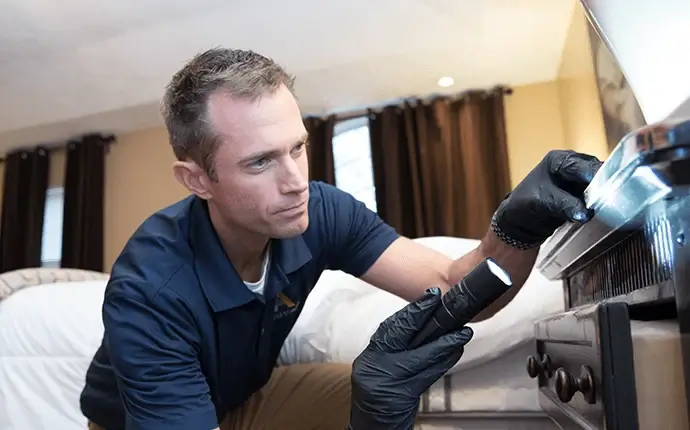
The Bedbug Problem
May 30, 2019
There’s nothing that quite makes the skin crawl like the prospect of bedbugs making your home their home--even the thought of them can leave you feeling itchy and nervous. This goes double as we enter into June and July, the peak time for bedbugs, and the months of the year when you’re most likely to see an infestation in your home. Luckily, there are a number of things that you can do to help prevent a bedbug infestation, and solutions available if you find yourself with an invasion in the coming months. Without further ado, let’s dive into the bedbug problem--and what you can do to stop them in their tracks.

How Can I Detect Bedbugs?
While visible to the naked eye, bedbugs are very small, good at hiding, and can be easily confused for other bugs, which makes actually spotting them a less effective way to recognize an infestation than other signs. Despite this, it’s still good to know what bedbugs look like, in case you do spot them; here’s a photo:

Note the ovular shape and reddish color; this is what a bedbug will look like after feeding on blood. An engorged bedbug will be easier to spot, because of the increase in size and distinct coloring. Still, they can be difficult to spot, even in this enlarged state. Luckily, they do leave behind a number of other easy to detect signs:
- Bites - The most notorious sign of bedbugs is their bites, and they can come in a variety of different patterns. Clusters of small, red, itchy welts that weren’t there before you went to bed, and/or welts that appear on uncovered areas in zig-zagged bite formations or straight rows, are all signs that there are bedbugs in your home. Be cautious about using bites as the surefire sign of an infestation, though: bites can be easily mistaken for other bug bites or skin conditions (like eczema), and some people don’t even have a reaction to bedbug bites.
- Spots on your bed - Bedbugs leave behind visible signs that aside from the bites on exposed skin. Because bedbugs feast on blood, they leave behind small blood stains after feeding; these stains are rust colored, and can usually be found spotting your sheets and pillow casings. While searching for blood stains, also keep an eye out for small, brown, oval shaped objects on your bedding and dark spots: bedbugs molt multiple times as they mature, leaving behind small exoskeletons which are often visible on bedding and mattresses, and will also sometimes leave dark excrement spots on the bed.
- Sniff them out - Another telltale sign that can let you know you have bedbugs is their distinct smell. Bedbugs emit a particularly stinky and detectable pheromone that smells a bit like a wet towel; if you notice that, “wet towel” smell in your room (assuming you don’t have wet towels strewn about the room) in tandem with one or more of the other signs outlined above, there’s a significant chance that you’re dealing with bedbugs.
- Eggs - Bedbug eggs, while small, are detectable by the human eye, and are easier to spot than a live bedbug. Roughly 1 mm in length, and off-white in color, the eggs are often laid in cracks and crevasses; if you’re searching for eggs to confirm suspicion of an infestation, check the buttons and edges of your mattress, the boxframe, and bedframe.
How Can I Prevent Bedbugs?
There are a couple of fairly simple precautions that you can take to help reduce the chances of bedbugs getting into your home:
- If you have a hankering for finding or buying previously owned furniture into your living space, do so with caution! Do a very careful check of any furniture that you’re bringing indoors to ensure that there are no signs of bedbugs.
- Try to keep living spaces clean. While bedbugs do not have a preference for clean or dirty environments, if you have a lot of clutter around it will be easier for them to find hiding places. Making sure you vacuum regularly can also help; it can suck up any stray bedbugs that might have gotten into your home before they can start multiplying, spreading around your home, and become an infestation.
- Covering any cracks or openings that could act as access points or hidey holes for bedbugs are smart preventative measures to take if you’re concerned about bedbugs getting in.
- Mattress and furniture covers are a great precautionary step to take to keep bedbugs out of your furniture: the slippery layer makes your furniture significantly more difficult to cling onto, and leaves fewer of the cracks and crevasses that bedbugs like to hide inaccessible.
What Can I Do If I Do Have An Infestation?
If you do find that you have bedbugs in your home or business, there are options. A1 offers a comprehensive bed bug control service, and we have expert experience eliminating them from all kinds of environments, from homes to churches to hotels. We have a four-step process rooted in getting bed bugs out of your space, and making sure that they are gone for good:
- Inspection: We send out an expert tech to the site of the infestation, and do a comprehensive inspection to assess the problem and then recommend treatment options and schedule extermination.
- Preparation: Once it’s clear that you’ll need treatment, our tech will consult with you to give you instructions for treatment preparation; this can include removing plants or pets from the home, getting rid of clutter, and removing and washing bedbug susceptible fabrics, amongst other things.
- Treatment: Based on our assessment and your needs, we will deploy a heat-based or chemical-based bedbug treatment to effectively kill the infestation.
- Follow Up: Our tech will schedule a follow-up visit with you to ensure that the pests are completely gone.
Because of our certainty in the comprehensive, effective nature of our four-step bed bug elimination process, we offer a 60 day bed bug free guarantee. If our treatment doesn’t totally eradicate the bugs from your home or business, we’ll be back to finish them off for good.
